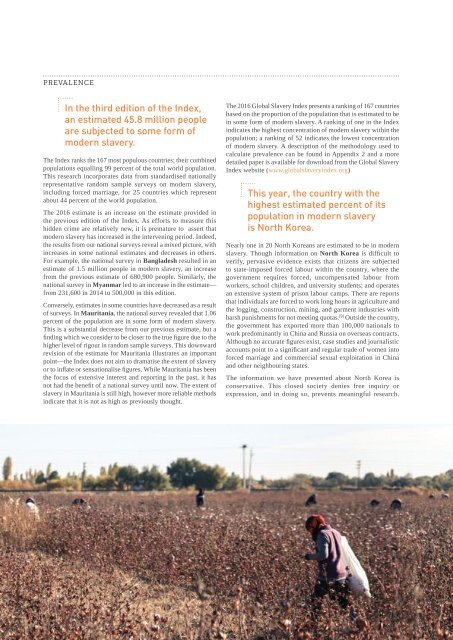GSI-2016-Full-Report
GSI-2016-Full-Report
GSI-2016-Full-Report
You also want an ePaper? Increase the reach of your titles
YUMPU automatically turns print PDFs into web optimized ePapers that Google loves.
PREVALENCE<br />
In the third edition of the Index,<br />
an estimated 45.8 million people<br />
are subjected to some form of<br />
modern slavery.<br />
The Index ranks the 167 most populous countries; their combined<br />
populations equalling 99 percent of the total world population.<br />
This research incorporates data from standardised nationally<br />
representative random sample surveys on modern slavery,<br />
including forced marriage, for 25 countries which represent<br />
about 44 percent of the world population.<br />
The <strong>2016</strong> estimate is an increase on the estimate provided in<br />
the previous edition of the Index. As efforts to measure this<br />
hidden crime are relatively new, it is premature to assert that<br />
modern slavery has increased in the intervening period. Indeed,<br />
the results from our national surveys reveal a mixed picture, with<br />
increases in some national estimates and decreases in others.<br />
For example, the national survey in Bangladesh resulted in an<br />
estimate of 1.5 million people in modern slavery, an increase<br />
from the previous estimate of 680,900 people. Similarly, the<br />
national survey in Myanmar led to an increase in the estimate—<br />
from 231,600 in 2014 to 500,000 in this edition.<br />
Conversely, estimates in some countries have decreased as a result<br />
of surveys. In Mauritania, the national survey revealed that 1.06<br />
percent of the population are in some form of modern slavery.<br />
This is a substantial decrease from our previous estimate, but a<br />
finding which we consider to be closer to the true figure due to the<br />
higher level of rigour in random sample surveys. This downward<br />
revision of the estimate for Mauritania illustrates an important<br />
point—the Index does not aim to dramatise the extent of slavery<br />
or to inflate or sensationalise figures. While Mauritania has been<br />
the focus of extensive interest and reporting in the past, it has<br />
not had the benefit of a national survey until now. The extent of<br />
slavery in Mauritania is still high, however more reliable methods<br />
indicate that it is not as high as previously thought.<br />
The <strong>2016</strong> Global Slavery Index presents a ranking of 167 countries<br />
based on the proportion of the population that is estimated to be<br />
in some form of modern slavery. A ranking of one in the Index<br />
indicates the highest concentration of modern slavery within the<br />
population; a ranking of 52 indicates the lowest concentration<br />
of modern slavery. A description of the methodology used to<br />
calculate prevalence can be found in Appendix 2 and a more<br />
detailed paper is available for download from the Global Slavery<br />
Index website (www.globalslaveryindex.org)<br />
This year, the country with the<br />
highest estimated percent of its<br />
population in modern slavery<br />
is North Korea.<br />
Nearly one in 20 North Koreans are estimated to be in modern<br />
slavery. Though information on North Korea is difficult to<br />
verify, pervasive evidence exists that citizens are subjected<br />
to state-imposed forced labour within the country, where the<br />
government requires forced, uncompensated labour from<br />
workers, school children, and university students; and operates<br />
an extensive system of prison labour camps. There are reports<br />
that individuals are forced to work long hours in agriculture and<br />
the logging, construction, mining, and garment industries with<br />
harsh punishments for not meeting quotas. [9] Outside the country,<br />
the government has exported more than 100,000 nationals to<br />
work predominantly in China and Russia on overseas contracts.<br />
Although no accurate figures exist, case studies and journalistic<br />
accounts point to a significant and regular trade of women into<br />
forced marriage and commercial sexual exploitation in China<br />
and other neighbouring states.<br />
The information we have presented about North Korea is<br />
conservative. This closed society denies free inquiry or<br />
expression, and in doing so, prevents meaningful research.<br />
24 | GLOBAL SLAVERY INDEX <strong>2016</strong>


